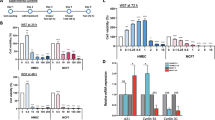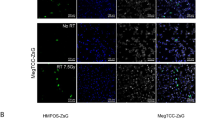Abstract
Arsenic trioxide (As2O3) is a novel anticancer agent, which has been found to induce remission in acute promyelocytic leukaemic patients following daily intravenous administration. The therapeutic value of As2O3 in other cancers is still largely unknown. Cytotoxic tests in a panel of cancer cell lines showed that bladder cancer, acute promyelocytic leukaemic and gastrointestinal cancer cells were the most sensitive to As2O3 among 17 cell lines tested. Cellular glutathione (GSH) system plays an important role in arsenic detoxification in mammalian cells. Cancer cells that were intrinsically sensitive to As2O3 contained lower levels of GSH, whereas resistant cancer cells contained higher levels of GSH. On the other hand, there was no association of glutathione-S-transferase-π or multidrug resistance-associated protein 1 levels with arsenic sensitivity in these cancer cells. Multidrug-resistant cancer cells that were cross-resistant to arsenic contained higher levels of GSH or multidrug-resistance-associated protein 1 than their drug-sensitive parental cells. Cancer cells become more sensitive to arsenic after depletion of cellular GSH with L-buthionine sulphoximine. We concluded that cellular GSH level is the most important determinant of arsenic sensitivity in cancer cells. Cellular GSH level and its modulation by buthionine sulphoximine should be considered in designing clinical trials using arsenic in solid tumours.
Similar content being viewed by others
Article PDF
Change history
16 November 2011
This paper was modified 12 months after initial publication to switch to Creative Commons licence terms, as noted at publication
References
Bailey, HH, Mulcahy, RT, Tutsch, KD, Arzoomanian, RZ, Alberti, D, Tombes, MB, Wilding, G, Pomplun, M & Spriggs, DR (1994) Phase I clinical trial of intravenous L-buthionine sulfoximine and melphalan: an attempt at modulation of glutathione. J Clin Oncol 12: 194–205
Cole, SP, Sparks, KE, Fraser, K, Loe, DW, Grant, CE, Wilson, GM & Deeley, RG (1994) Pharmacological characterization of multidrug resistant MRP-transfected human tumor cells. Cancer Res 54: 5902–5910
Chen, GQ, Shi, XG, Tang, W, Xiong, SM, Zhu, J, Cai, X, Han, ZG, Ni, JH, Shi, GY, Jia, PM, Liu, MM, He, KL, Niu, C, Ma, J, Zhang, P, Zhang, TD, Paul, P, Naoe, T, Kitamura, K, Miller, W, Waxman, S, Wang, ZY, de The, H, Chen, SJ & Chen, Z (1997) Use of arsenic trioxide (As2O3) in the treatment of acute promyelocytic leukemia (APL): I. As2O3 exerts dose-dependent dual effects on APL cells. Blood 89: 3345–3353
Flens, MJ, Izquierdo, MA, Scheffer, GL, Fritz, JM, Meijer, CJ, Scheper, RJ & Zaman, GJ (1994) Immunochemical detection of the multidrug resistance-associated protein MRP in human multidrug-resistant tumor cells by monoclonal antibodies. Cancer Res 54: 4557–4563
Gallagher, RE (1998) Arsenic: new life for an old potion. N Engl J Med 339: 1389–1391
Huang, H, Huang, CF, Wu, DR, Jinn, CM & Jan, KY (1993) Glutathione as a cellular defence against arsenite toxicity in cultured Chinese hamster ovary cells. Toxicology 79: 195–204
Konig, A, Wrazel, L, Warrell, RP, Jr., Rivi, R, Pandolfi, PP, Jakubowski, A & Gabrilove, JL (1997) Comparative activity of melarsoprol and arsenic trioxide in chronic B-cell leukemia lines. Blood 90: 562–570
Lo, JF, Wang, HF, Tam, MF & Lee, TC (1992) Glutathione S-transferase pi in an arsenic-resistant Chinese hamster ovary cell line. Biochem J 288: 977–982
Rappa, G, Lorico, A, Flavell, RA & Sartorelli, AC (1997) Evidence that the multidrug resistance protein (MRP) functions as a co-transporter of glutathione and natural product toxins. Cancer Res 57: 5232–5237
Schneider, E, Horton, JK, Yang, CH, Nakagawa, M & Cowan, KH (1994) Multidrug resistance-associated protein gene overexpression and reduced drug sensitivity of topoisomerase II in a human breast carcinoma MCF7 cell line selected for etoposide resistance. Cancer Res 54: 152–158
Scott, N, Hatlelid, KM, MacKenzie, NE & Carter, DE (1993) Reactions of arsenic(III) and arsenic(V) species with glutathione. Chem Res Toxicol 6: 102–106
Shen, ZX, Chen, GQ, Ni, JH, Li, XS, Xiong, SM, Qiu, QY, Zhu, J, Tang, W, Sun, GL, Yang, KQ, Chen, Y, Zhou, L, Fang, ZW, Wang, YT, Ma, J, Zhang, P, Zhang, TD, Chen, SJ, Chen, Z & Wang, ZY (1997) Use of arsenic trioxide (As2O3) in the treatment of acute promyelocytic leukemia (APL): II. Clinical efficacy and pharmacokinetics in relapsed patients. Blood 89: 3354–3360
Skehan, P, Storeng, R, Scudiero, D, Monks, A, McMahon, J, Vistica, D, Warren, JT, Bokesch, H, Kenney, S & Boyd, MR (1990) New colorimetric cytotoxicity assay for anticancer-drug screening. J Natl Cancer Inst 82: 1107–1112
Soignet, SL, Maslak, P, Wang, ZG, Jhanwar, S, Calleja, E, Dardashti, LJ, Corso, D, DeBlasio, A, Gabrilove, J, Scheinberg, DA, Pandolfi, PP & Warrell, RP Jr (1998) Complete remission after treatment of acute promyelocytic leukemia with arsenic trioxide. N Engl J Med 339: 1341–1348
Tzeng, CC, Liu, HS, Li, C, Jin, YT, Chen, RM, Yang, WH & Lin, JS (1996) Characterization of two urothelium cancer cell lines derived from a blackfoot disease endemic area in Taiwan. Anticancer Res 16: 1797–1804
Wang, HF & Lee, TC (1993) Glutathione S-transferase pi facilitates the excretion of arsenic from arsenic-resistant Chinese hamster ovary cells. Biochem & Biophys Res Communication 192: 1093–1099
Yu, HJ, Tsai, TC, Hsieh, TS & Chiu, TY (1992) Characterization of a newly established human bladder carcinoma cell line, NTUB1. J Formosan Med Ass 91: 608–613
Author information
Authors and Affiliations
Rights and permissions
From twelve months after its original publication, this work is licensed under the Creative Commons Attribution-NonCommercial-Share Alike 3.0 Unported License. To view a copy of this license, visit http://creativecommons.org/licenses/by-nc-sa/3.0/
About this article
Cite this article
Yang, CH., Kuo, ML., Chen, JC. et al. Arsenic trioxide sensitivity is associated with low level of glutathione in cancer cells. Br J Cancer 81, 796–799 (1999). https://doi.org/10.1038/sj.bjc.6690766
Received:
Revised:
Accepted:
Published:
Issue date:
DOI: https://doi.org/10.1038/sj.bjc.6690766
Keywords
This article is cited by
-
An overview of arsenic trioxide-involved combined treatment algorithms for leukemia: basic concepts and clinical implications
Cell Death Discovery (2023)
-
Effects of Combined Exposure to Chronic High-Fat Diet and Arsenic on Thyroid Function and Lipid Profile in Male Mouse
Biological Trace Element Research (2018)
-
Dihydroartemisinin Sensitizes Human Lung Adenocarcinoma A549 Cells to Arsenic Trioxide via Apoptosis
Biological Trace Element Research (2017)
-
Resveratrol Synergistically Triggers Apoptotic Cell Death with Arsenic Trioxide via Oxidative Stress in Human Lung Adenocarcinoma A549 Cells
Biological Trace Element Research (2015)
-
Arsenic Trioxide and Reduced Glutathione Act Synergistically to Augment Inhibition of Thyroid Peroxidase Activity In Vitro
Biological Trace Element Research (2015)



